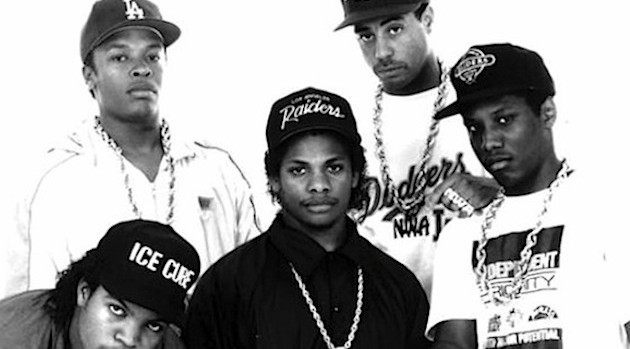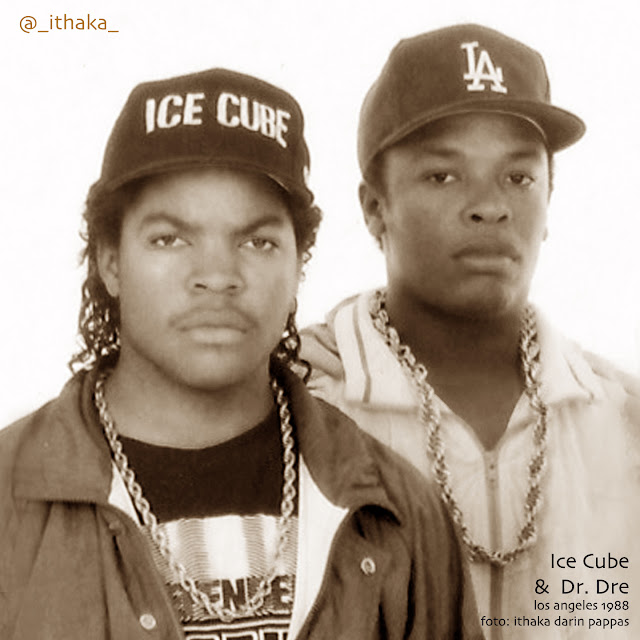photo: Ithaka Darin Pappas ©1988
This was one of many shoots
that I did of NWA members for
Priority Records between 1988 and 1991.
For more information about this image
please contact: ithaka.art@gmail.com - Also see: @_ithaka_
Note: This image is not Public Domain, it is necessary to acquire authorization
thru my representatives at the Tack Artist Group Agency in Los Angeles
before reproducing in print, online or merchandising...thank you.
http://thehundreds.com/ithaka-interview/
~~~~~~~~~~~~~~~~~~~~~
http://consequenceofsound.net/2015/07/will-the-real-n-w-a-please-stand-up/
Will the Real N.W.A Please Stand Up?
Can you really integrate a rap group called Niggaz Wit Attitudes?
BY MATT MELIS
ON JULY 26, 2015, 11:30PM
3 COMMENTS
<img width="807" height="694" src="https://consequenceofsound.files.wordpress.com/2015/07/nwa.jpg?w=807" class="attachment-single-thumb size-single-thumb wp-post-image" alt="nwa" />
- FACEBOOK
TWITTER
TUMBLR
REDDIT
Interesting 4 Not Interesting <iframe src="//www.googletagmanager.com/ns.html?id=GTM-MZL2QJ" height="0" width="0" style="display:none;visibility:hidden"></iframe> <div style="display: none;"> <img src="http://pixel.quantserve.com/pixel/p-test123.gif" height="1" width="1" alt="Quantcast"/> </div> <img src="http://b.scorecardresearch.com/p?c1=7&c2=15566811&c3=1793&cv=2.0&cj=1" /> <img src="https://d5nxst8fruw4z.cloudfront.net/atrk.gif?account=jaMOi1a8Dy00q7" style="display:none" height="1" width="1" alt="" />
Share
Tweet
<iframe src="//www.googletagmanager.com/ns.html?id=GTM-MZL2QJ" height="0" width="0" style="display:none;visibility:hidden"></iframe>
Photo by Ithaka Darin Pappas / Tack Artist Group
Music, Movies & Moods is a regular free-form column in which Matt Melis (@MistaMelis) explores the cracks between where art and daily life meet.
One afternoon during sophomore year of high school, our guidance counselor passed out a questionnaire asking about our futures: college plans, career interests, etc. Before submitting the forms, my friend Ed shared one of his responses with me. Dream job: N.W.A crew member. Fallback: Mechanical engineer. Ed, who spent most evenings recording raps on his computer and wore a No Limit Records jersey each day to school, tried to maintain a steely expression, but his pale, freckled face soon surrendered a grin. As much as he worshipped hip-hop culture, Ed understood that he lacked a basic requirement for landing his dream gig. N.W.A, defunct or not, wasn’t hiring any white rappers. Nearly 20 years later, things aren’t so simple.
Last week, Universal Pictures chairperson Donna Langley stated that a full-blown N.W.A reunion tour was being organized to coincide with the release of filmmaker F. Gary Gray’s upcoming biopic, Straight Outta Compton. More surprising, though, was the suggestion that Dr. Dre protégé Eminem might fill in for the late Eric “Eazy-E” Wright as an honorary member. Initially, the news read like an Onion story, a joke akin to Dave Chapelle’s sketch about a blind black man rising through the ranks of the Ku Klux Klan. How can you integrate a hip-hop group called Niggaz Wit Attitudes? Dre and Eminem’s camps quickly quashed the rumor, but an idea can’t be smothered so neatly. What exactly would it mean for a seminal gangsta rap outfit to tour with a white member in 2015? Would it say something positive about music’s power to transcend differences, or would it only deepen the racial confusion that America currently finds itself mired in?
<div class="player-unavailable"><h1 class="message">An error occurred.</h1><div class="submessage"><a href="http://www.youtube.com/watch?v=OrlLcb7zYmw" target="_blank">Try watching this video on www.youtube.com</a>, or enable JavaScript if it is disabled in your browser.</div></div>
When Obama defeated McCain in a landslide in 2008, people of all colors could be overheard talking optimistically about the possibility of a post-racial America in the near future. The last 12 months have made that dream seem sadly naïve and depressingly distant. Since the shooting of Michael Brown last August, the US has been bombarded by cases of police violence towards blacks, alit with racially charged riots, and draped in debate over issues like flying the Northern Virginia battle flag at the South Carolina State House. Issues of race feel inescapable in 2015, and never in my adult life have questions about what it means to be black or white in America felt any less black-and-white.
Rachel Dolezal will likely end up as a strange footnote in America’s ongoing discussions on race. For over a year, Dolezal, a white woman, passed as black and acted as president of the Spokane chapter of the NAACP before being racially outed by her parents last month. Public reaction ran the gamut from accusations of blackface and minstrelsy to discussions on whether racial identity can be self-determined, with most accepting that Dolezal’s race-change, regardless of intention, only proved the extent of her privilege as a white woman in America. Dolezal may be an extreme case, but her story does illuminate legitimate questions about the boundaries existing between white and black experience: Where do the lines between human solidarity and encroachment, between appropriation and exploitation fall; are they permanent demarcations; and who determines them?
<div class="player-unavailable"><h1 class="message">An error occurred.</h1><div class="submessage"><a href="http://www.youtube.com/watch?v=9GP5XRcN6T8" target="_blank">Try watching this video on www.youtube.com</a>, or enable JavaScript if it is disabled in your browser.</div></div>
Since its commercialization, hip-hop has acted as a cultural gatekeeper, largely defining which aspects of urban black experience whites – white youth in particular – are permitted to be privy to and participate in. In Signifying Rappers, David Foster Wallace and Mark Costello liken whites listening to rap music to a ride in a fortified, fast-moving train through the dangerous neighborhoods portrayed throughout the genre – a type of cultural voyeurism with many of the thrills but none of the peril of the actual experience. Subsequently, white youth in search of modes of expression that seemed more authentic than what their suburban worlds offered began allophiliacally adopting hip-hop mannerisms, language, and fashion, and eventually the art form opened up to artists from all backgrounds. However, certain black hip-hop groups, like Public Enemy and N.W.A, made one thing patently clear: whites could be with them (buying records and in the audience), but not one of them.
That’s part of what made the alleged tap on Eminem’s shoulder so mystifying. The very name N.W.A signifies an identity inextricably connected to a particular race, time, and place. “We needed a name,” Ice Cube explains in his short film Straight Outta L.A., “something that would leave no doubt about what we was about and where we was from.” Eminem, for all his skills on the mic and respect within the industry, has no connection to that foundational identity – to the specific environment and circumstances that made N.W.A a dire outlet for its members. Like the rest of us, Em was relegated to the sidelines, learning about Compton via Straight Outta Compton.
<div class="player-unavailable"><h1 class="message">An error occurred.</h1><div class="submessage"><a href="http://www.youtube.com/watch?v=J0y00AiXHfU" target="_blank">Try watching this video on www.youtube.com</a>, or enable JavaScript if it is disabled in your browser.</div></div>
In the same film, rapper Ice-T notes, “One of the lyrics in ‘Straight Outta Compton’ says, ‘From the gang called Niggaz Wit Attitudes.’ They didn’t call themselves a rap group. They said, ‘We’re a gang.’” It’s a critical distinction. A rap group can relocate, but a gang is chained to its turf. The fundamental purpose of N.W.A was to report life as its members experienced or witnessed it in their hometown, and never has a hip-hop group been so tightly bound to a city. More than two decades later, the name N.W.A still conjures images of southern LA, the black and silver Raiders gear, and the ’92 riots that, in hindsight, seemed to be foreshadowed by the pent-up anger and frustration found in the group’s two studio albums. To bring in someone from outside that experience to redeliver those reports from the frontlines seems unconscionable, a mission statement- and group-negating act. If N.W.A doesn’t represent that singular experience, then what exactly does it mean?
One of the reasons this discussion is worth having owes to the fact that N.W.A are more relevant today than they were even just a year ago. With controversial cuts like “Fuck Tha Police”, they became one of the earliest hip-hop groups to explicitly voice anger about the treatment of African-Americans by the authorities. “It’s crazy how we were getting criticized for this years ago,” Dre recently told Rolling Stone. “And now, it’s just like, ‘Ok, we understand.’ This is a problem that keeps happening still today.” It pierces our deepest integrity as a society that a song like “Fuck Tha Police” even exists, but not a month has gone by over the past year that we haven’t been reminded why the song needs to exist.
<div class="player-unavailable"><h1 class="message">An error occurred.</h1><div class="submessage"><a href="http://www.youtube.com/watch?v=mqUtJn_wxIQ" target="_blank">Try watching this video on www.youtube.com</a>, or enable JavaScript if it is disabled in your browser.</div></div>
Eazy-E drops a line in “Fuck Tha Police” that could just as easily have been written in 2015: “They [the police] put out my picture with silence/ ‘Cause my identity by itself causes violence.” He doesn’t deliver the line with any braggadocio, but rather as a simple statement of fact. When I hear that line, a river of names from the past year rushes through my mind – names of people who look nothing like Ed, Eminem, or myself. Eazy-E’s words call attention to the work still left to be done nearly 30 years later, but they also remind me that sometimes our role is to simply pass the mic and listen.


















